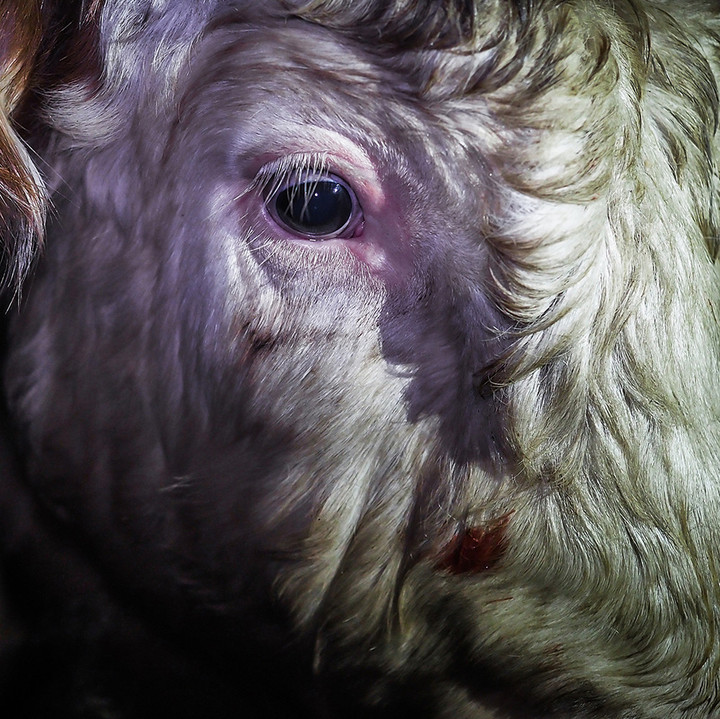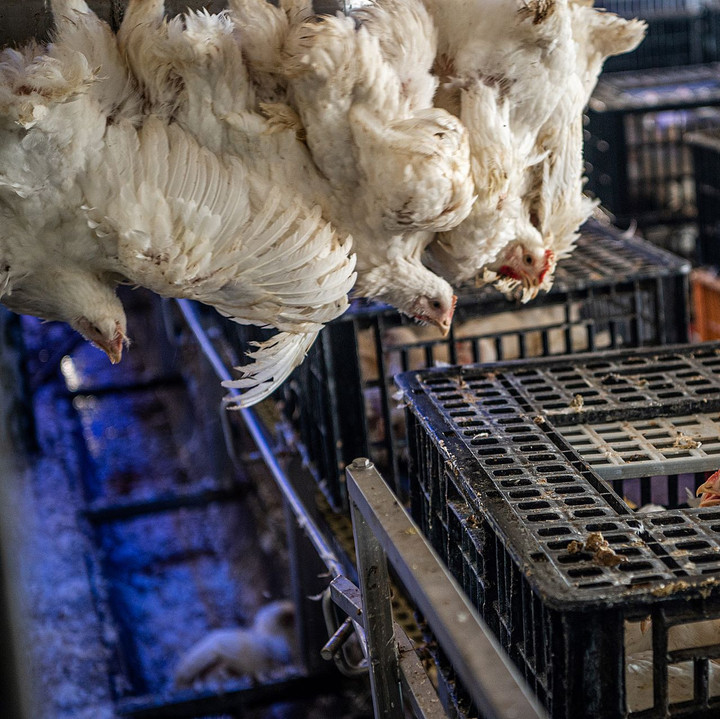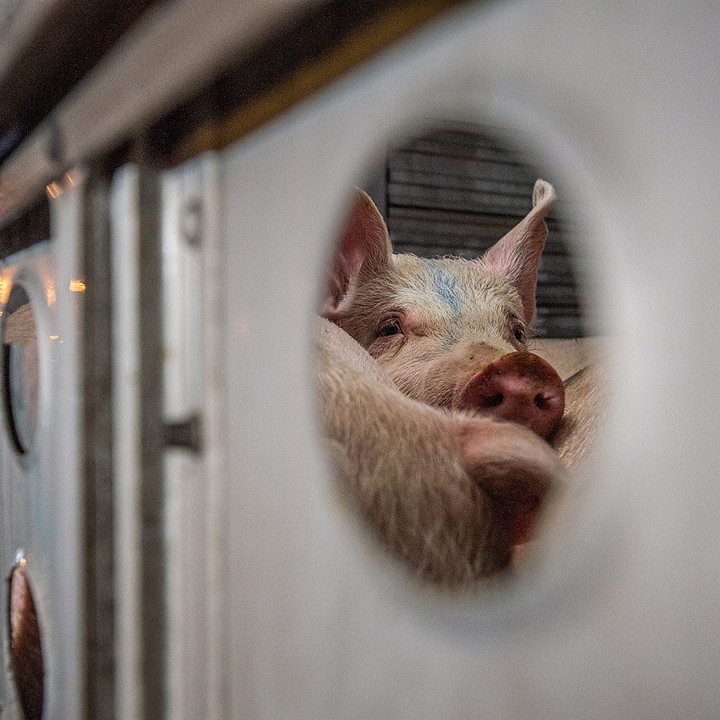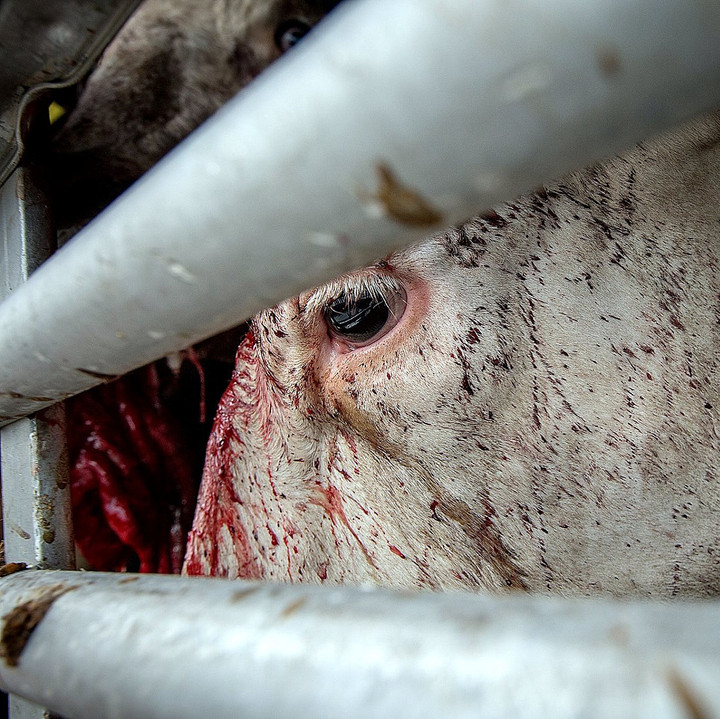
Slaughtering of Farm Animals – Animal Welfare Issues
Even if there are many detailed legal requirements on how to deal with animals at the slaughterhouse, violations occur again and again
Warning: The following content may be disturbing to some people.
Larger slaughterhouses throughout the European Union are obliged to appoint an animal welfare officer and his deputy1. However, the animal welfare officers are usually employed directly by the slaughterhouse and sooner or later adapt to the 'common practice' and corporate culture prevailing there.
According to EFSA (European Food Safety Authority), the most common cause of an animal's negative or painful experience during transport to and from the slaughterhouse is the way it is handled by humans2. A lack of knowledge about the respective animal species, for example about the locomotion pattern and how to drive animals as stress-free as possible, but also over-tiredness and stress are the main reasons why the animals are not handled appropriately.
The offences can be set actively and consciously or arise passively through ignorance or due to the structural situation and equipment of the slaughterhouse. Failure to do so and toleration of unlawful behaviour also leads to animal suffering and is observed just as frequently in slaughterhouses3.
Active animal welfare offences
Active animal welfare offences are understood to be all animal welfare-related actions that are actively and consciously taken by the slaughterhouse staff, but also by people working in the area of delivery and unloading, such as transporters or farmers. The justification for these is almost always the strong time pressure due to a quick slaughter speed4.
Unfortunately, the motivation for good, patient handling of the animals is also rather low because the current opinion is that the animals don’t have much longer to live anyway and therefore good handling isn’t necessary.
Passive animal welfare offences
Passive animal welfare offences are not committed consciously or actively but can mainly be traced back to poor infrastructure in the various slaughterhouse areas, such as delivery or the holding pen, poor maintenance of the facilities and equipment, and lack of education on the part of the staff5.
Violations of animal welfare regulations are still common.⁶

Common observations – delivery, unloading and entry

Passive offences – during delivery, unloading, driving to stun

Passive offences when driving to the facilities
Learn more

Active offences in stunning and bleeding
Learn more
Common observations of veterinarians on slaughterhouses
Offences during delivery, unloading and moving into the holding pen
The following very detailed listing of common offences have been presented at the Austrian Animal Welfare Conference in 2013 and has not lost its relevance and importance to this day and is intended to show what the last way of many so-called farm animals looks like throughout Europe.
Overloading of transport
In many cases, the loading density is massively exceeded. The transported animals cannot stand in their natural position or lie down to rest. If they do so, they have to lie in their faeces and are at risk to be trampled on as there is very little space on the vehicles.
In the cold season, when the outside temperatures are low, large areas of frostbite can occur in those animals that are in direct contact with the cold metal walls of the vehicle when overloaded. There is a misconception that trucks should be loaded more densely than normal, especially when temperatures are below zero, so that the animals can warm each other up.
Transport vehicles are not unloaded for too long
If transport vehicles are not unloaded immediately at the slaughterhouse, long waiting times result in fights, such as bulls being mounted. The problem is that the animals loaded onto the same transport vehicle do not necessarily know each other. They may come from the same farm but have lived there in different bays. On the collection tours, transport companies also collect animals from different companies.
Encountering strange animals and the stress of having to face fights is a major burden for the animals.
If the transport vehicles are also left in the blazing sun for a long time without adequate weather protection and fans, this can lead to the animals overheating. A water supply in the truck is not normally provided.
No isolation of sick or injured animals
Before transport, the animal owner must decide on the farm whether the animal intended for slaughter is transportable. Although it is forbidden to transport injured or seriously ill animals, it still happens that such animals, which are unfit for transport, are loaded and transported to the slaughterhouse.
Sick or injured animals are often not transported separately from healthy animals. If the tailgates are opened at the slaughterhouse, these animals remain on the truck or in the aisle and the remaining animals are driven over them. This leads to severe stress and injuries to the animals, which are already affected.
Time pressure and hectic unloading
If the loading flap is opened, the animals are often required to leave the vehicle immediately and quickly. You are not given time to get an overview of the new situation and get out of the vehicle independently at your own pace.
Use of driving aids and aggressive driving
The use of driving aids is not prohibited but should only be used when necessary. In practice, the use of prods such as electric prods, sticks, whips and pitchforks often happens “out of habit” even though the animals move independently. Even when there is no place to move or move on, prodding aids are used thoughtlessly.
Massive bodily harm while driving
Punches and kicks, also on sensitive parts of the body (udders, testicles, eyes, stomach) are used to urge animals to move on faster. Tail twisting, which is still not considered a welfare offence by herdsmen, continues to be practised. During the meat inspection at the end of the slaughter, the seriousness of some offences comes to light.
Inadequate handling of disabled or injured animals
For various reasons, disabled and injured animals are not stunned and bled at the transport vehicle or ramp to ensure a quick death. They are sometimes abused with electric prods or sticks, even though they are obviously unable to move. Despite being prohibited, they are often pulled into the holding pens or stunning area with a lift or by hand by their horns, head, ears, tail or feet. The reason for this is to prevent additional cleaning of the vehicle or the aisle.
No consideration for the condition of the animals
Sick and injured animals are often not slaughtered as quickly as possible. They are often housed together with other healthy animals or slaughtered at the very end so as not to disturb the slaughtering process. Pigs, for example, have often already died by then.
Frequent passive offences during the delivery, unloading and transporting into the holding pen and the stunning box
The most common animal welfare offences are observed in the area of delivery and unloading.
Unnecessarily caused injuries while unloading through carelessness or convenience
It happens again and again that animals fall off the ramp during unloading and injure themselves badly. The reason for this is, on the one hand, that the lateral borders are not high enough and cannot be sufficiently adapted to the different vehicles. On the other hand, the protective device is often not used at all during unloading 'out of convenience or time pressure'.
In addition, the injured animals that have fallen are not stunned and bled on the spot, but are dragged into the stunning area, like animals that have already been delivered sick or injured.
Animals are not given time to get used to the environment
Poor lighting conditions (from bright daylight to a black hole), obstacles in the raceway, excessive noise levels in the holding pen or animals that are in the raceway and not in the holding pens due to overcrowding can unsettle animals and prevent them from moving on. If the forcing flow is interrupted, unnecessary forcing aids are used and crowding can occur, which causes further problems, for example when animals that do not know each other meet.
Slippery floors that pose a great risk of injury
Again and again, it happens that animals slip and fall on damp floors smeared with excrement and mirror-smooth due to wear and tear. This can lead to straddling of the hind legs and fractures of limbs or the pelvis. How these animals are treated can be deduced from the above point.
The problem, which not only causes stress for the animals but also for the staff, could be solved by spreading straw or sawdust.
Defective device resulting in injury
It is not uncommon for injuries to occur due to metal parts protruding into the raceway. Due to cracks in the floor and defective sewer gratings or due to too great a distance between grating bars through which they can climb.
Common passive offences when transporting into the stunning box
The following problems can be observed most frequently in pushing the animals to be stunned.
Poorly designed driveways
A faulty design of the separation of the animals, e.g. in the shape of a funnel, often causes the animals to become wedged and the forcing flow to be disturbed. This in turn leads to the use of unnecessary driving aids.
Backstops, designed to prevent animals from backing up in fear or panic, may be improperly designed, causing animals to become trapped and injure themselves.
Reflecting surfaces and dazzling lamps
Highly reflective or dazzling surfaces (e.g., bright stainless-steel surfaces in the trap) or lamps irritate the animals and make them shy, stop or push back. This means that propellants, such as the stun gun, may have to be used twice to ensure the correct shot.
Steps and elevations on driveways
If there are steps when driving in, for example in the stunning gondola for pig slaughter, the already panicked animals can stumble and fall there.
Obsolete stun traps
Incorrectly designed traps/stun boxes, which do not allow the animals to be securely fixed, for example, are often a major problem. If the stunning devices take too much time to apply safely or are made completely difficult, this leads to massive stress for the animals and, in the worst case, to miss and have to redo the procedure.
Common active offences during stunning and bleeding
During the processes of stunning and bleeding, active animal welfare offences by veterinarians are observed less frequently, but violations still occur in this very sensitive area.
Inappropriate electrocution prior to stunning
Particularly in small slaughterhouses that stun pigs with electrical stunning, and when animals are stunned in a group, it can happen that workers attempt to get the animals in place using electrical tongs. Recording of the stunning current is not mandatory in small slaughterhouses, which means that these short electric shocks are not documented. If a recording were necessary, these short electric shocks would be documented as false stunning.
Overloading the gondola during CO₂ stunning of the pigs
With CO₂ stunning in pigs, the gondolas that lower the animals into the CO₂ lake are often loaded with more animals than intended by the manufacturer. This results in additional stress for the animals when they are driven into the gondola despite the lack of space. With more animals in the space, the stunning effectiveness is not sufficient. The narrowness of the gondola restricts breathing movements, which means that they absorb less CO₂ than intended. As soon as they lose their ability to stand in the gondola, they lie on top of each other, which further restricts breathing.
The insufficient stunning leads to animals possibly waking up prematurely. Since many animals must be loaded and unloaded during the slaughtering time, two factors come into play here: The animals are not stunned for a sufficiently long time and many animals that need to be stunned. It can happen that the last animals in the same group are at risk of being conscious during the slicing of their throats.
Electric shock when driving into the stunning box
Cattle often refuse to make the final steps into the stunning box where they are then restrained for stunning. In order to get the animals into the box faster, electric shockers are often used.
Painful suffering from too high a slaughtering speed
The animal's death is a result of the blood loss that occurs after cutting their throat, but it does not happen right away. It takes some time before the animal dies. If the slaughtering speed is too high, additional preparation work may be started before the animal has even died, such as scalding pig bristles or removing the feet, horns, or muzzle of cattle.
Source
2 EFSA. (2020). Welfare of pigs at slaughter. The EFSA Journal 18(6)., EFSA. (2020); Welfare of cattle at slaughter. EFSA Journal; 18(11):6275.
3, 4, 5, 6 Fötschl, H. (2013). Animal welfare offenses at the slaughterhouse. Animal welfare: Claim - Responsibility - Reality. Conference report of the 4th ÖTT conference (pp. 29-35). Vienna: Johannes Baumgartner.

